Foreign Currency Exposure: A Comparison of Tools and Methods Employed by Apple Inc and Samsung
VerifiedAdded on 2023/06/15
|10
|2459
|82
AI Summary
This report analyzes the foreign currency transaction exposures of Apple Inc and Samsung, and the tools and methods employed by both companies for managing foreign currency exposure. A comparison is made between the two companies, highlighting similarities and differences in their approaches. Critical evaluation is also provided.
Contribute Materials
Your contribution can guide someone’s learning journey. Share your
documents today.
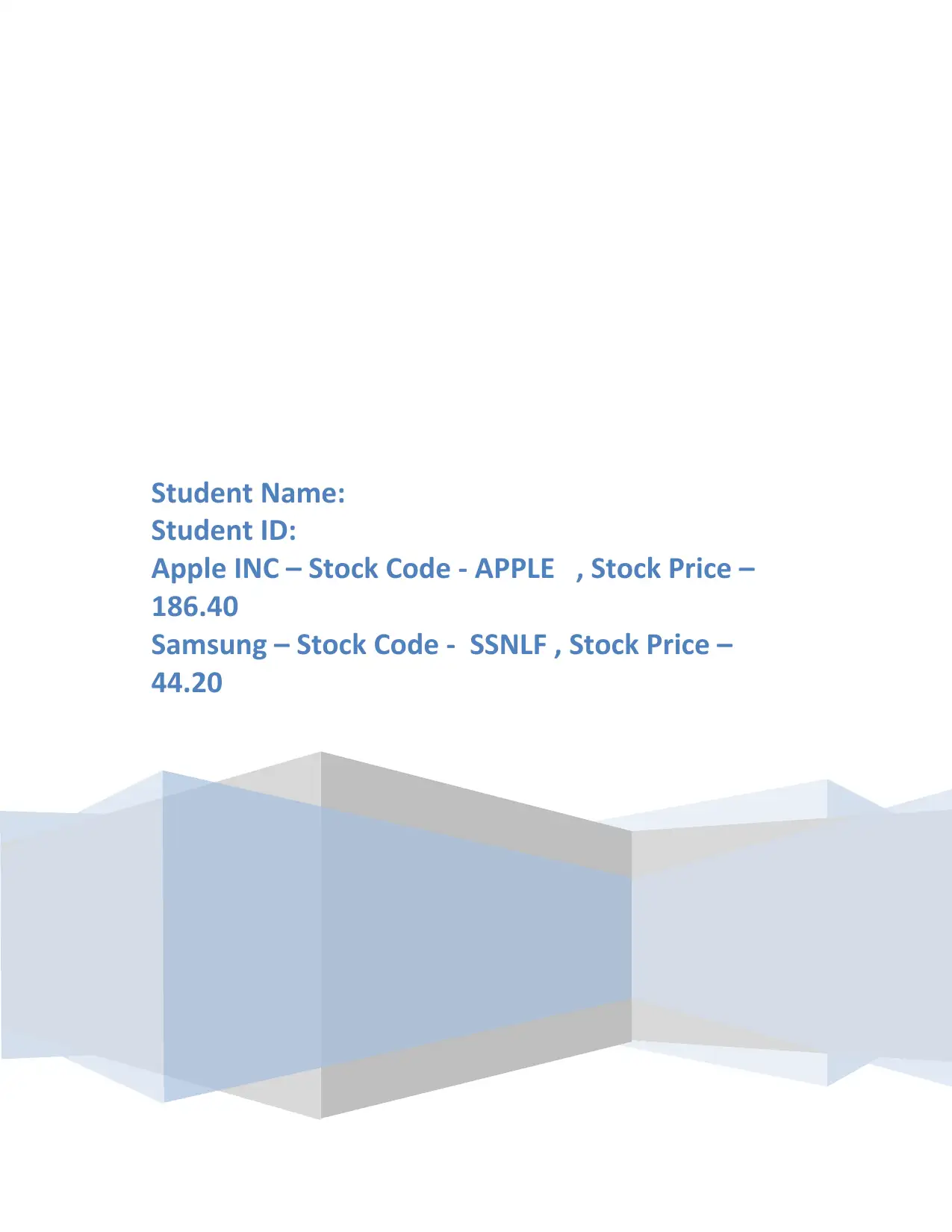
Student Name:
Student ID:
Apple INC – Stock Code - APPLE , Stock Price –
186.40
Samsung – Stock Code - SSNLF , Stock Price –
44.20
Student ID:
Apple INC – Stock Code - APPLE , Stock Price –
186.40
Samsung – Stock Code - SSNLF , Stock Price –
44.20
Secure Best Marks with AI Grader
Need help grading? Try our AI Grader for instant feedback on your assignments.
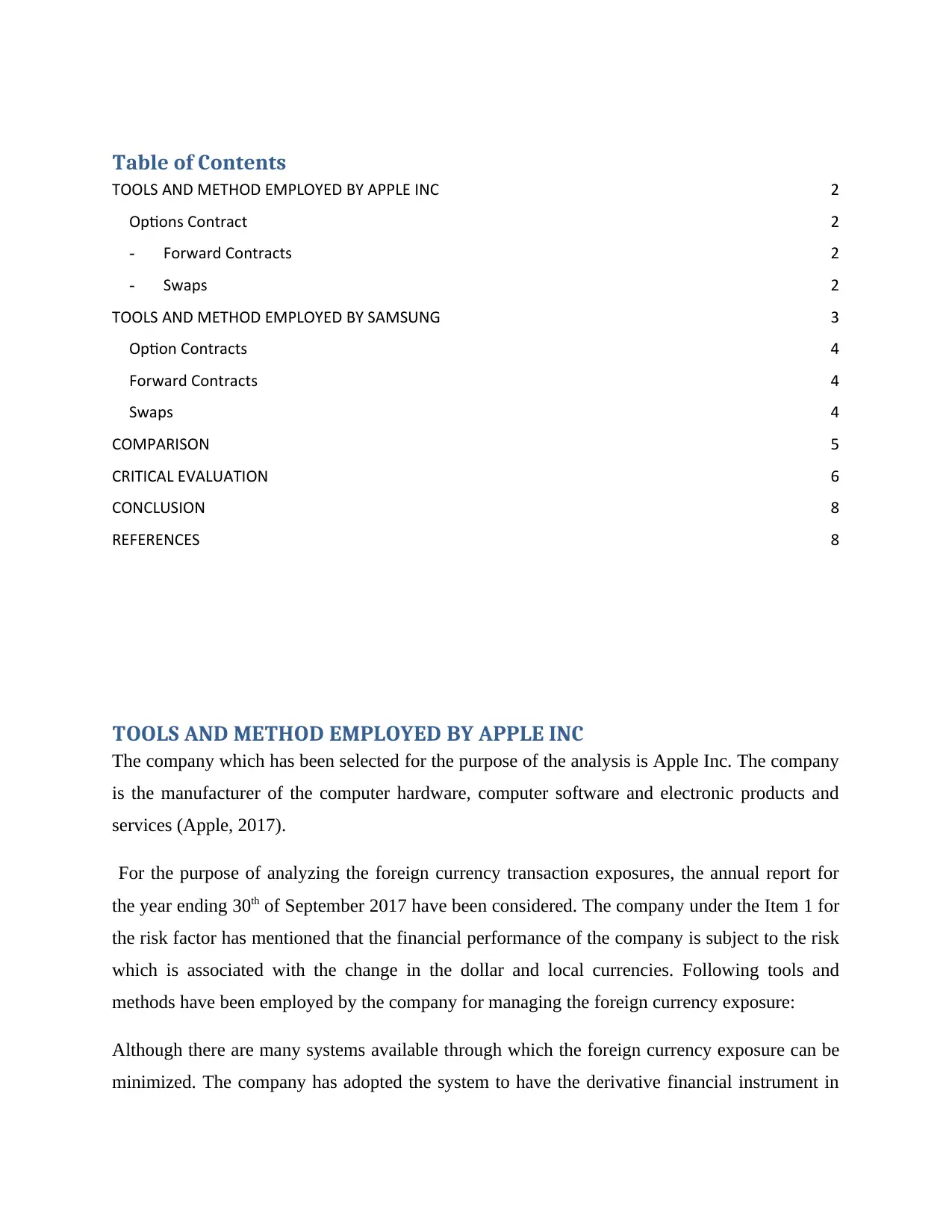
Table of Contents
TOOLS AND METHOD EMPLOYED BY APPLE INC 2
Options Contract 2
- Forward Contracts 2
- Swaps 2
TOOLS AND METHOD EMPLOYED BY SAMSUNG 3
Option Contracts 4
Forward Contracts 4
Swaps 4
COMPARISON 5
CRITICAL EVALUATION 6
CONCLUSION 8
REFERENCES 8
TOOLS AND METHOD EMPLOYED BY APPLE INC
The company which has been selected for the purpose of the analysis is Apple Inc. The company
is the manufacturer of the computer hardware, computer software and electronic products and
services (Apple, 2017).
For the purpose of analyzing the foreign currency transaction exposures, the annual report for
the year ending 30th of September 2017 have been considered. The company under the Item 1 for
the risk factor has mentioned that the financial performance of the company is subject to the risk
which is associated with the change in the dollar and local currencies. Following tools and
methods have been employed by the company for managing the foreign currency exposure:
Although there are many systems available through which the foreign currency exposure can be
minimized. The company has adopted the system to have the derivative financial instrument in
TOOLS AND METHOD EMPLOYED BY APPLE INC 2
Options Contract 2
- Forward Contracts 2
- Swaps 2
TOOLS AND METHOD EMPLOYED BY SAMSUNG 3
Option Contracts 4
Forward Contracts 4
Swaps 4
COMPARISON 5
CRITICAL EVALUATION 6
CONCLUSION 8
REFERENCES 8
TOOLS AND METHOD EMPLOYED BY APPLE INC
The company which has been selected for the purpose of the analysis is Apple Inc. The company
is the manufacturer of the computer hardware, computer software and electronic products and
services (Apple, 2017).
For the purpose of analyzing the foreign currency transaction exposures, the annual report for
the year ending 30th of September 2017 have been considered. The company under the Item 1 for
the risk factor has mentioned that the financial performance of the company is subject to the risk
which is associated with the change in the dollar and local currencies. Following tools and
methods have been employed by the company for managing the foreign currency exposure:
Although there are many systems available through which the foreign currency exposure can be
minimized. The company has adopted the system to have the derivative financial instrument in
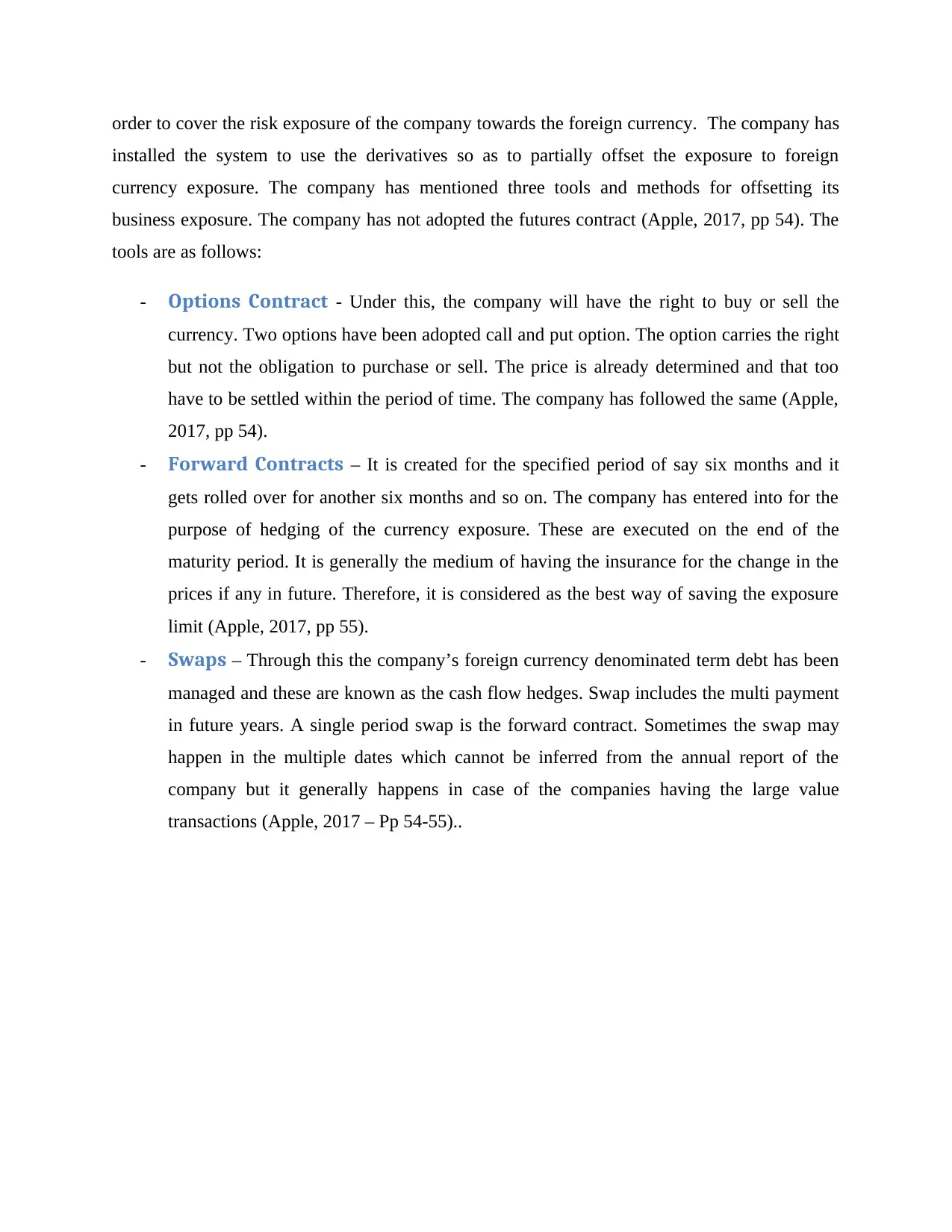
order to cover the risk exposure of the company towards the foreign currency. The company has
installed the system to use the derivatives so as to partially offset the exposure to foreign
currency exposure. The company has mentioned three tools and methods for offsetting its
business exposure. The company has not adopted the futures contract (Apple, 2017, pp 54). The
tools are as follows:
- Options Contract - Under this, the company will have the right to buy or sell the
currency. Two options have been adopted call and put option. The option carries the right
but not the obligation to purchase or sell. The price is already determined and that too
have to be settled within the period of time. The company has followed the same (Apple,
2017, pp 54).
- Forward Contracts – It is created for the specified period of say six months and it
gets rolled over for another six months and so on. The company has entered into for the
purpose of hedging of the currency exposure. These are executed on the end of the
maturity period. It is generally the medium of having the insurance for the change in the
prices if any in future. Therefore, it is considered as the best way of saving the exposure
limit (Apple, 2017, pp 55).
- Swaps – Through this the company’s foreign currency denominated term debt has been
managed and these are known as the cash flow hedges. Swap includes the multi payment
in future years. A single period swap is the forward contract. Sometimes the swap may
happen in the multiple dates which cannot be inferred from the annual report of the
company but it generally happens in case of the companies having the large value
transactions (Apple, 2017 – Pp 54-55)..
installed the system to use the derivatives so as to partially offset the exposure to foreign
currency exposure. The company has mentioned three tools and methods for offsetting its
business exposure. The company has not adopted the futures contract (Apple, 2017, pp 54). The
tools are as follows:
- Options Contract - Under this, the company will have the right to buy or sell the
currency. Two options have been adopted call and put option. The option carries the right
but not the obligation to purchase or sell. The price is already determined and that too
have to be settled within the period of time. The company has followed the same (Apple,
2017, pp 54).
- Forward Contracts – It is created for the specified period of say six months and it
gets rolled over for another six months and so on. The company has entered into for the
purpose of hedging of the currency exposure. These are executed on the end of the
maturity period. It is generally the medium of having the insurance for the change in the
prices if any in future. Therefore, it is considered as the best way of saving the exposure
limit (Apple, 2017, pp 55).
- Swaps – Through this the company’s foreign currency denominated term debt has been
managed and these are known as the cash flow hedges. Swap includes the multi payment
in future years. A single period swap is the forward contract. Sometimes the swap may
happen in the multiple dates which cannot be inferred from the annual report of the
company but it generally happens in case of the companies having the large value
transactions (Apple, 2017 – Pp 54-55)..
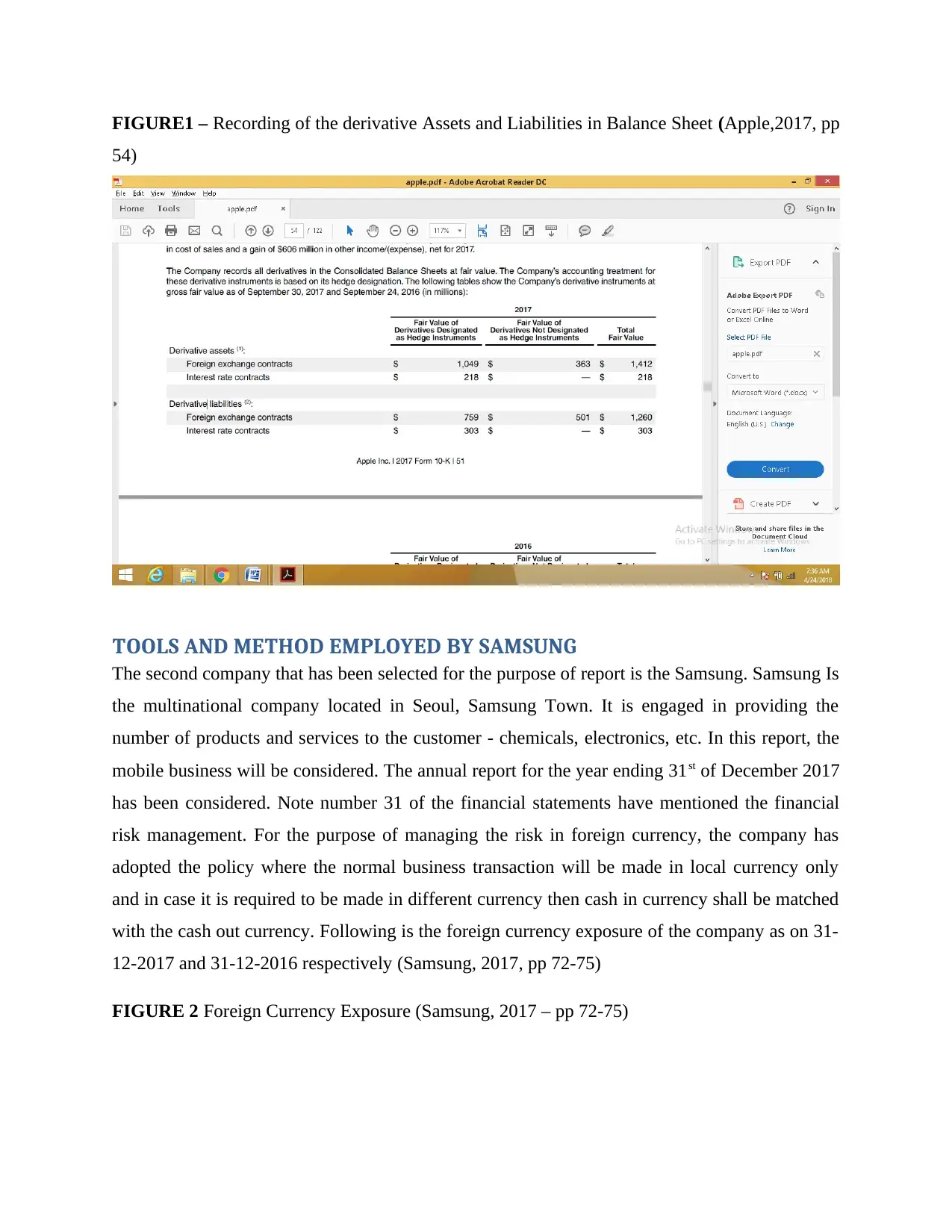
FIGURE1 – Recording of the derivative Assets and Liabilities in Balance Sheet (Apple,2017, pp
54)
TOOLS AND METHOD EMPLOYED BY SAMSUNG
The second company that has been selected for the purpose of report is the Samsung. Samsung Is
the multinational company located in Seoul, Samsung Town. It is engaged in providing the
number of products and services to the customer - chemicals, electronics, etc. In this report, the
mobile business will be considered. The annual report for the year ending 31st of December 2017
has been considered. Note number 31 of the financial statements have mentioned the financial
risk management. For the purpose of managing the risk in foreign currency, the company has
adopted the policy where the normal business transaction will be made in local currency only
and in case it is required to be made in different currency then cash in currency shall be matched
with the cash out currency. Following is the foreign currency exposure of the company as on 31-
12-2017 and 31-12-2016 respectively (Samsung, 2017, pp 72-75)
FIGURE 2 Foreign Currency Exposure (Samsung, 2017 – pp 72-75)
54)
TOOLS AND METHOD EMPLOYED BY SAMSUNG
The second company that has been selected for the purpose of report is the Samsung. Samsung Is
the multinational company located in Seoul, Samsung Town. It is engaged in providing the
number of products and services to the customer - chemicals, electronics, etc. In this report, the
mobile business will be considered. The annual report for the year ending 31st of December 2017
has been considered. Note number 31 of the financial statements have mentioned the financial
risk management. For the purpose of managing the risk in foreign currency, the company has
adopted the policy where the normal business transaction will be made in local currency only
and in case it is required to be made in different currency then cash in currency shall be matched
with the cash out currency. Following is the foreign currency exposure of the company as on 31-
12-2017 and 31-12-2016 respectively (Samsung, 2017, pp 72-75)
FIGURE 2 Foreign Currency Exposure (Samsung, 2017 – pp 72-75)
Secure Best Marks with AI Grader
Need help grading? Try our AI Grader for instant feedback on your assignments.
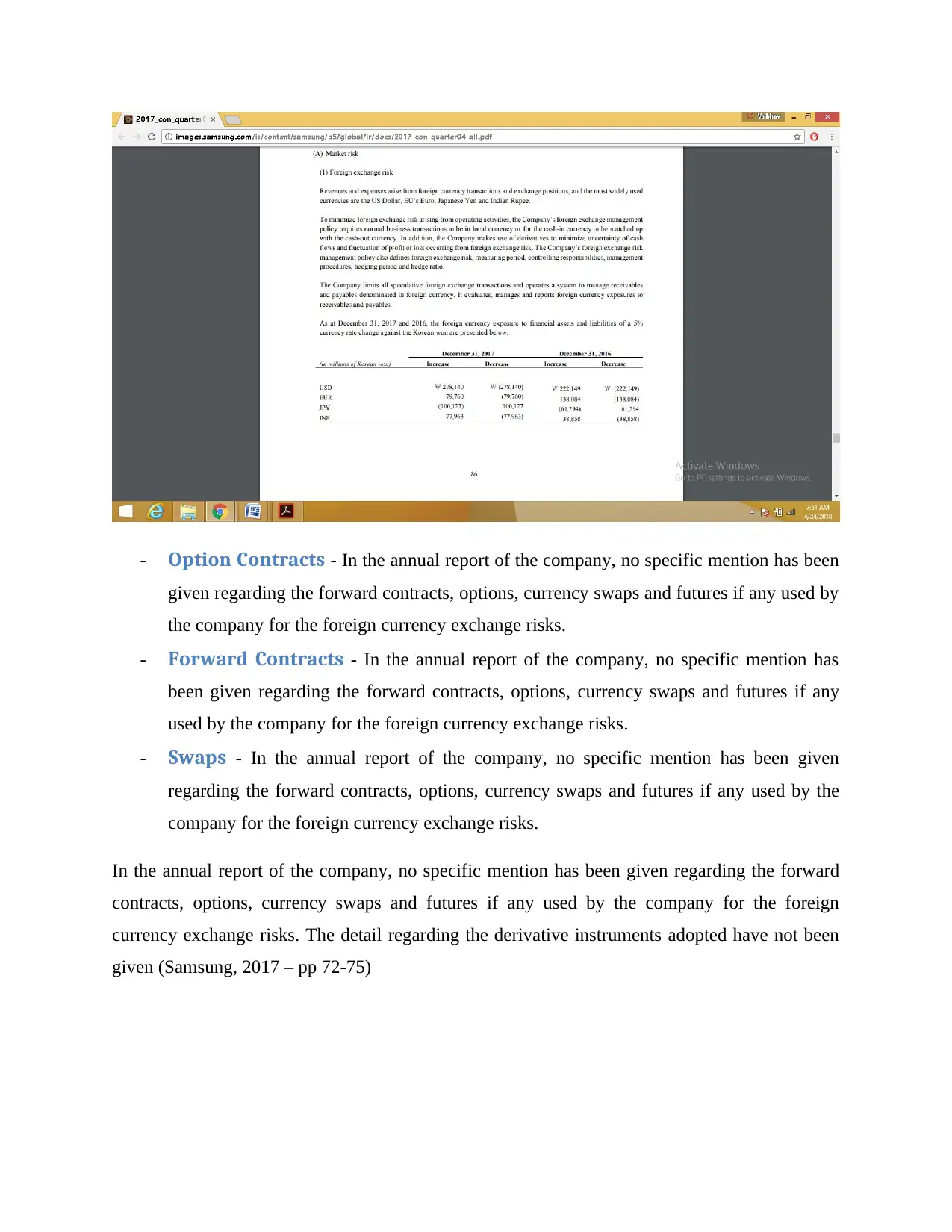
- Option Contracts - In the annual report of the company, no specific mention has been
given regarding the forward contracts, options, currency swaps and futures if any used by
the company for the foreign currency exchange risks.
- Forward Contracts - In the annual report of the company, no specific mention has
been given regarding the forward contracts, options, currency swaps and futures if any
used by the company for the foreign currency exchange risks.
- Swaps - In the annual report of the company, no specific mention has been given
regarding the forward contracts, options, currency swaps and futures if any used by the
company for the foreign currency exchange risks.
In the annual report of the company, no specific mention has been given regarding the forward
contracts, options, currency swaps and futures if any used by the company for the foreign
currency exchange risks. The detail regarding the derivative instruments adopted have not been
given (Samsung, 2017 – pp 72-75)
given regarding the forward contracts, options, currency swaps and futures if any used by
the company for the foreign currency exchange risks.
- Forward Contracts - In the annual report of the company, no specific mention has
been given regarding the forward contracts, options, currency swaps and futures if any
used by the company for the foreign currency exchange risks.
- Swaps - In the annual report of the company, no specific mention has been given
regarding the forward contracts, options, currency swaps and futures if any used by the
company for the foreign currency exchange risks.
In the annual report of the company, no specific mention has been given regarding the forward
contracts, options, currency swaps and futures if any used by the company for the foreign
currency exchange risks. The detail regarding the derivative instruments adopted have not been
given (Samsung, 2017 – pp 72-75)
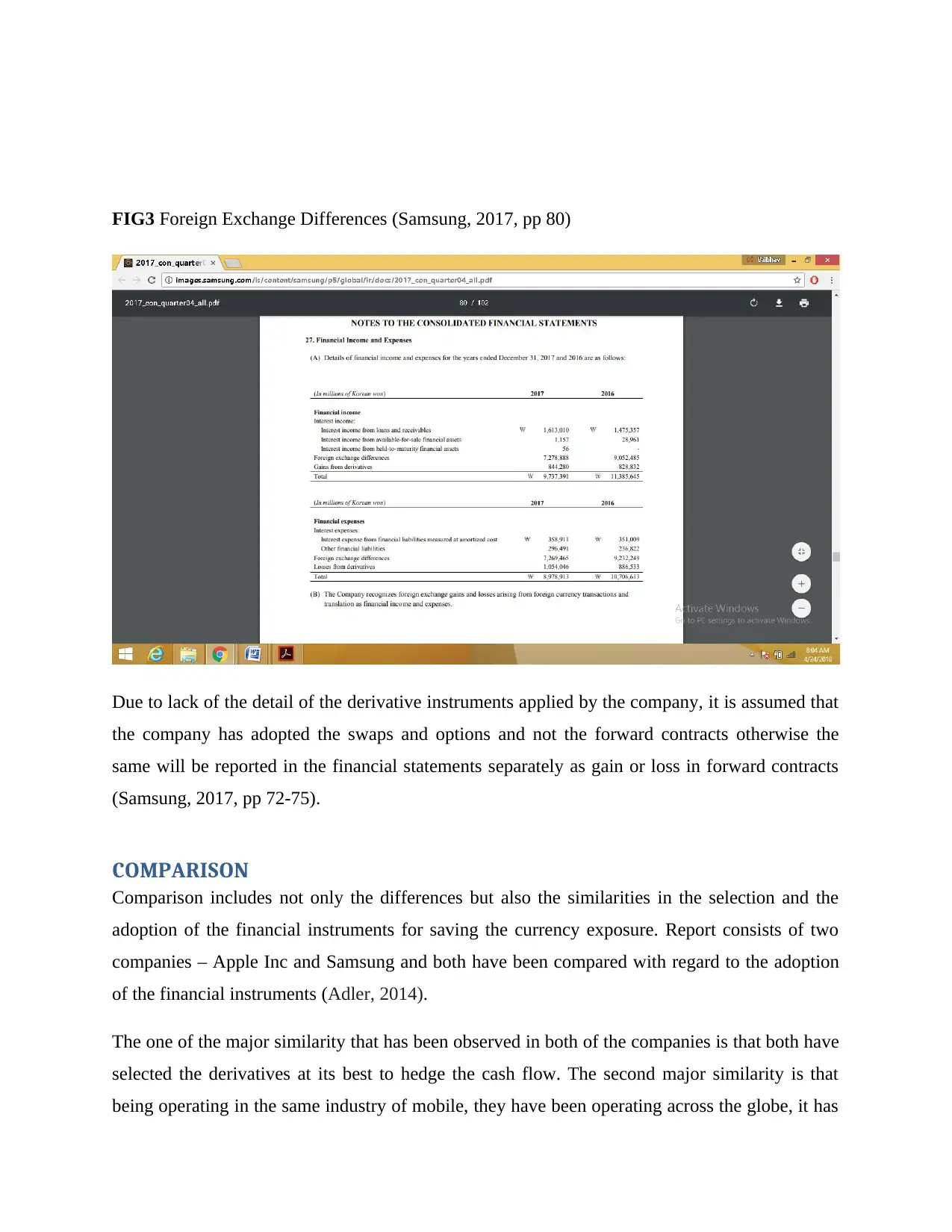
FIG3 Foreign Exchange Differences (Samsung, 2017, pp 80)
Due to lack of the detail of the derivative instruments applied by the company, it is assumed that
the company has adopted the swaps and options and not the forward contracts otherwise the
same will be reported in the financial statements separately as gain or loss in forward contracts
(Samsung, 2017, pp 72-75).
COMPARISON
Comparison includes not only the differences but also the similarities in the selection and the
adoption of the financial instruments for saving the currency exposure. Report consists of two
companies – Apple Inc and Samsung and both have been compared with regard to the adoption
of the financial instruments (Adler, 2014).
The one of the major similarity that has been observed in both of the companies is that both have
selected the derivatives at its best to hedge the cash flow. The second major similarity is that
being operating in the same industry of mobile, they have been operating across the globe, it has
Due to lack of the detail of the derivative instruments applied by the company, it is assumed that
the company has adopted the swaps and options and not the forward contracts otherwise the
same will be reported in the financial statements separately as gain or loss in forward contracts
(Samsung, 2017, pp 72-75).
COMPARISON
Comparison includes not only the differences but also the similarities in the selection and the
adoption of the financial instruments for saving the currency exposure. Report consists of two
companies – Apple Inc and Samsung and both have been compared with regard to the adoption
of the financial instruments (Adler, 2014).
The one of the major similarity that has been observed in both of the companies is that both have
selected the derivatives at its best to hedge the cash flow. The second major similarity is that
being operating in the same industry of mobile, they have been operating across the globe, it has
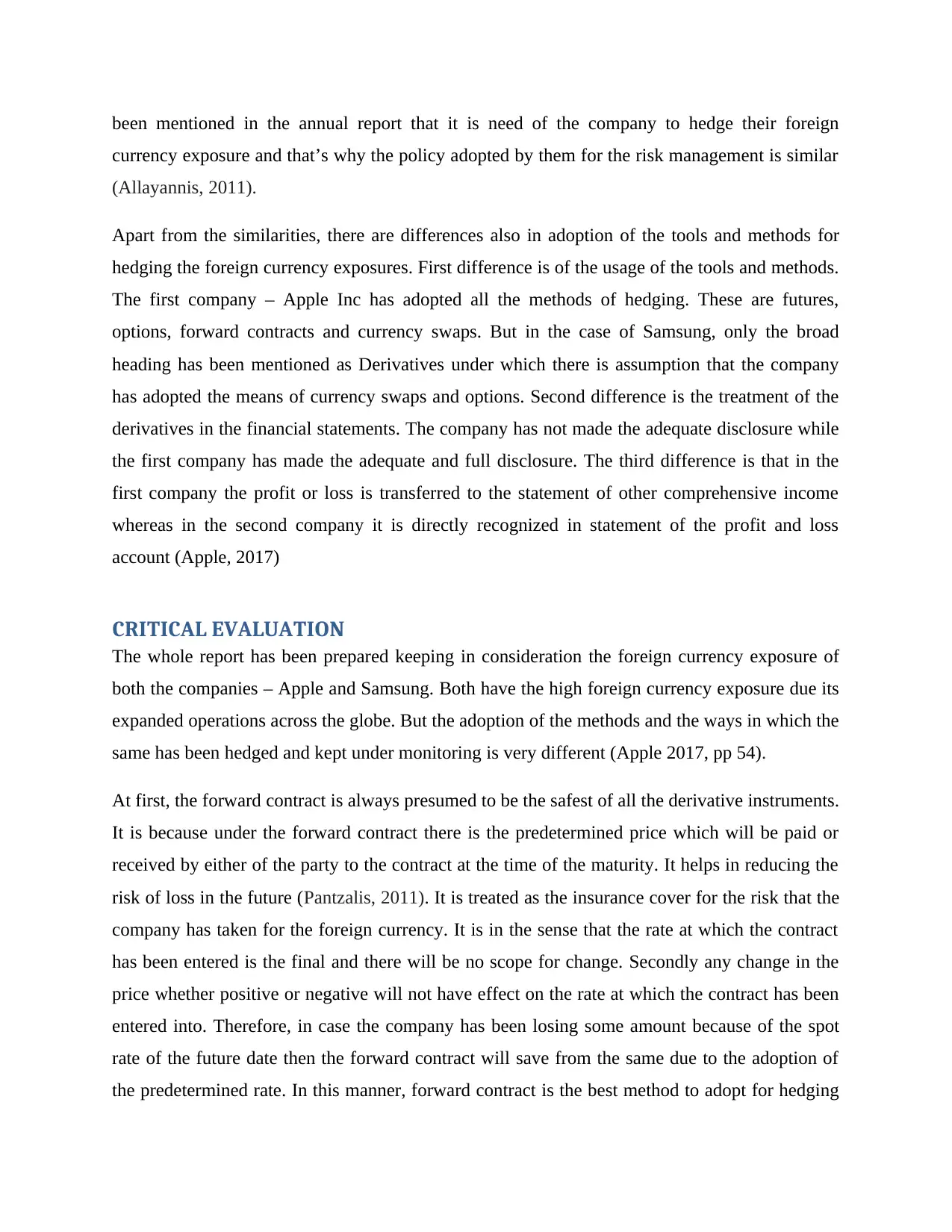
been mentioned in the annual report that it is need of the company to hedge their foreign
currency exposure and that’s why the policy adopted by them for the risk management is similar
(Allayannis, 2011).
Apart from the similarities, there are differences also in adoption of the tools and methods for
hedging the foreign currency exposures. First difference is of the usage of the tools and methods.
The first company – Apple Inc has adopted all the methods of hedging. These are futures,
options, forward contracts and currency swaps. But in the case of Samsung, only the broad
heading has been mentioned as Derivatives under which there is assumption that the company
has adopted the means of currency swaps and options. Second difference is the treatment of the
derivatives in the financial statements. The company has not made the adequate disclosure while
the first company has made the adequate and full disclosure. The third difference is that in the
first company the profit or loss is transferred to the statement of other comprehensive income
whereas in the second company it is directly recognized in statement of the profit and loss
account (Apple, 2017)
CRITICAL EVALUATION
The whole report has been prepared keeping in consideration the foreign currency exposure of
both the companies – Apple and Samsung. Both have the high foreign currency exposure due its
expanded operations across the globe. But the adoption of the methods and the ways in which the
same has been hedged and kept under monitoring is very different (Apple 2017, pp 54).
At first, the forward contract is always presumed to be the safest of all the derivative instruments.
It is because under the forward contract there is the predetermined price which will be paid or
received by either of the party to the contract at the time of the maturity. It helps in reducing the
risk of loss in the future (Pantzalis, 2011). It is treated as the insurance cover for the risk that the
company has taken for the foreign currency. It is in the sense that the rate at which the contract
has been entered is the final and there will be no scope for change. Secondly any change in the
price whether positive or negative will not have effect on the rate at which the contract has been
entered into. Therefore, in case the company has been losing some amount because of the spot
rate of the future date then the forward contract will save from the same due to the adoption of
the predetermined rate. In this manner, forward contract is the best method to adopt for hedging
currency exposure and that’s why the policy adopted by them for the risk management is similar
(Allayannis, 2011).
Apart from the similarities, there are differences also in adoption of the tools and methods for
hedging the foreign currency exposures. First difference is of the usage of the tools and methods.
The first company – Apple Inc has adopted all the methods of hedging. These are futures,
options, forward contracts and currency swaps. But in the case of Samsung, only the broad
heading has been mentioned as Derivatives under which there is assumption that the company
has adopted the means of currency swaps and options. Second difference is the treatment of the
derivatives in the financial statements. The company has not made the adequate disclosure while
the first company has made the adequate and full disclosure. The third difference is that in the
first company the profit or loss is transferred to the statement of other comprehensive income
whereas in the second company it is directly recognized in statement of the profit and loss
account (Apple, 2017)
CRITICAL EVALUATION
The whole report has been prepared keeping in consideration the foreign currency exposure of
both the companies – Apple and Samsung. Both have the high foreign currency exposure due its
expanded operations across the globe. But the adoption of the methods and the ways in which the
same has been hedged and kept under monitoring is very different (Apple 2017, pp 54).
At first, the forward contract is always presumed to be the safest of all the derivative instruments.
It is because under the forward contract there is the predetermined price which will be paid or
received by either of the party to the contract at the time of the maturity. It helps in reducing the
risk of loss in the future (Pantzalis, 2011). It is treated as the insurance cover for the risk that the
company has taken for the foreign currency. It is in the sense that the rate at which the contract
has been entered is the final and there will be no scope for change. Secondly any change in the
price whether positive or negative will not have effect on the rate at which the contract has been
entered into. Therefore, in case the company has been losing some amount because of the spot
rate of the future date then the forward contract will save from the same due to the adoption of
the predetermined rate. In this manner, forward contract is the best method to adopt for hedging
Paraphrase This Document
Need a fresh take? Get an instant paraphrase of this document with our AI Paraphraser
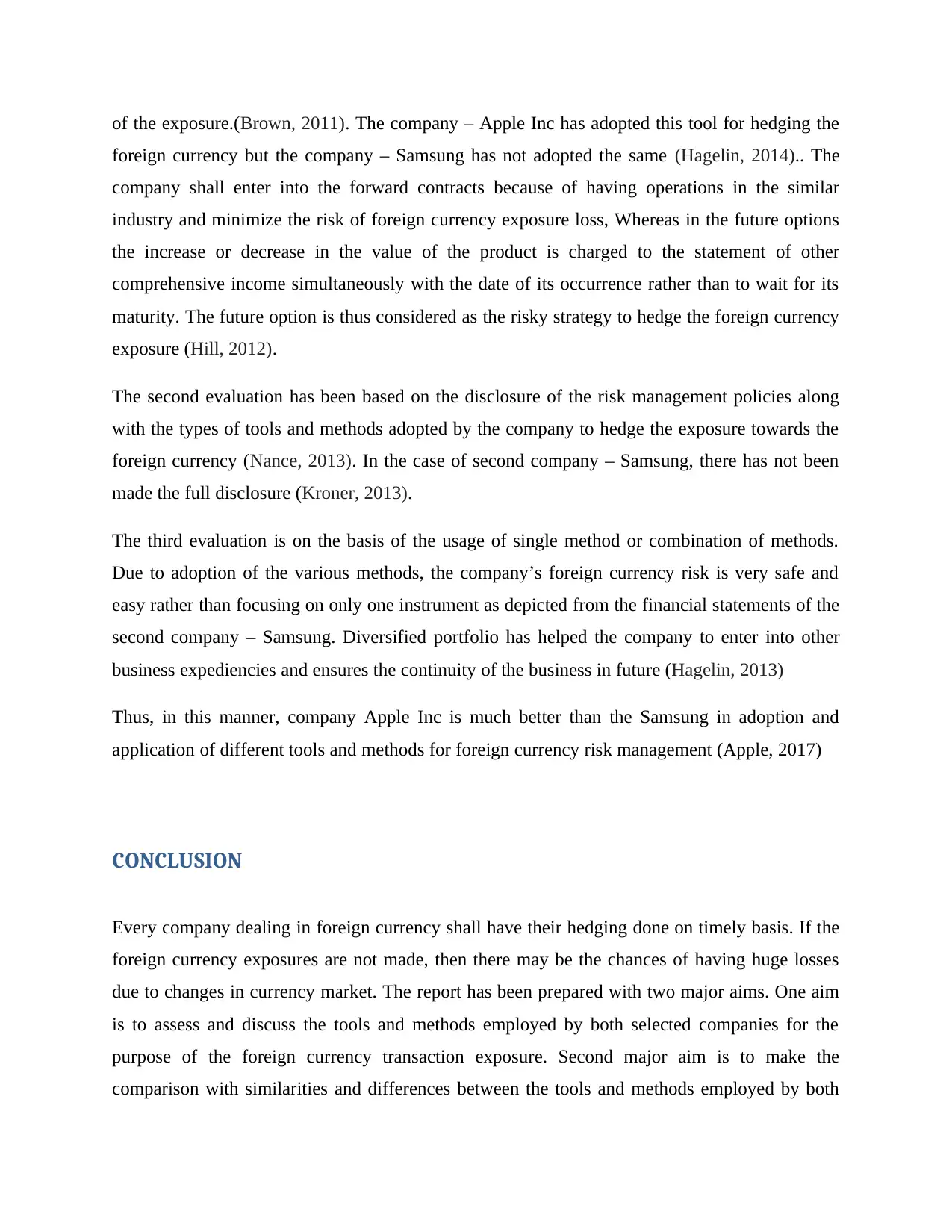
of the exposure.(Brown, 2011). The company – Apple Inc has adopted this tool for hedging the
foreign currency but the company – Samsung has not adopted the same (Hagelin, 2014).. The
company shall enter into the forward contracts because of having operations in the similar
industry and minimize the risk of foreign currency exposure loss, Whereas in the future options
the increase or decrease in the value of the product is charged to the statement of other
comprehensive income simultaneously with the date of its occurrence rather than to wait for its
maturity. The future option is thus considered as the risky strategy to hedge the foreign currency
exposure (Hill, 2012).
The second evaluation has been based on the disclosure of the risk management policies along
with the types of tools and methods adopted by the company to hedge the exposure towards the
foreign currency (Nance, 2013). In the case of second company – Samsung, there has not been
made the full disclosure (Kroner, 2013).
The third evaluation is on the basis of the usage of single method or combination of methods.
Due to adoption of the various methods, the company’s foreign currency risk is very safe and
easy rather than focusing on only one instrument as depicted from the financial statements of the
second company – Samsung. Diversified portfolio has helped the company to enter into other
business expediencies and ensures the continuity of the business in future (Hagelin, 2013)
Thus, in this manner, company Apple Inc is much better than the Samsung in adoption and
application of different tools and methods for foreign currency risk management (Apple, 2017)
CONCLUSION
Every company dealing in foreign currency shall have their hedging done on timely basis. If the
foreign currency exposures are not made, then there may be the chances of having huge losses
due to changes in currency market. The report has been prepared with two major aims. One aim
is to assess and discuss the tools and methods employed by both selected companies for the
purpose of the foreign currency transaction exposure. Second major aim is to make the
comparison with similarities and differences between the tools and methods employed by both
foreign currency but the company – Samsung has not adopted the same (Hagelin, 2014).. The
company shall enter into the forward contracts because of having operations in the similar
industry and minimize the risk of foreign currency exposure loss, Whereas in the future options
the increase or decrease in the value of the product is charged to the statement of other
comprehensive income simultaneously with the date of its occurrence rather than to wait for its
maturity. The future option is thus considered as the risky strategy to hedge the foreign currency
exposure (Hill, 2012).
The second evaluation has been based on the disclosure of the risk management policies along
with the types of tools and methods adopted by the company to hedge the exposure towards the
foreign currency (Nance, 2013). In the case of second company – Samsung, there has not been
made the full disclosure (Kroner, 2013).
The third evaluation is on the basis of the usage of single method or combination of methods.
Due to adoption of the various methods, the company’s foreign currency risk is very safe and
easy rather than focusing on only one instrument as depicted from the financial statements of the
second company – Samsung. Diversified portfolio has helped the company to enter into other
business expediencies and ensures the continuity of the business in future (Hagelin, 2013)
Thus, in this manner, company Apple Inc is much better than the Samsung in adoption and
application of different tools and methods for foreign currency risk management (Apple, 2017)
CONCLUSION
Every company dealing in foreign currency shall have their hedging done on timely basis. If the
foreign currency exposures are not made, then there may be the chances of having huge losses
due to changes in currency market. The report has been prepared with two major aims. One aim
is to assess and discuss the tools and methods employed by both selected companies for the
purpose of the foreign currency transaction exposure. Second major aim is to make the
comparison with similarities and differences between the tools and methods employed by both
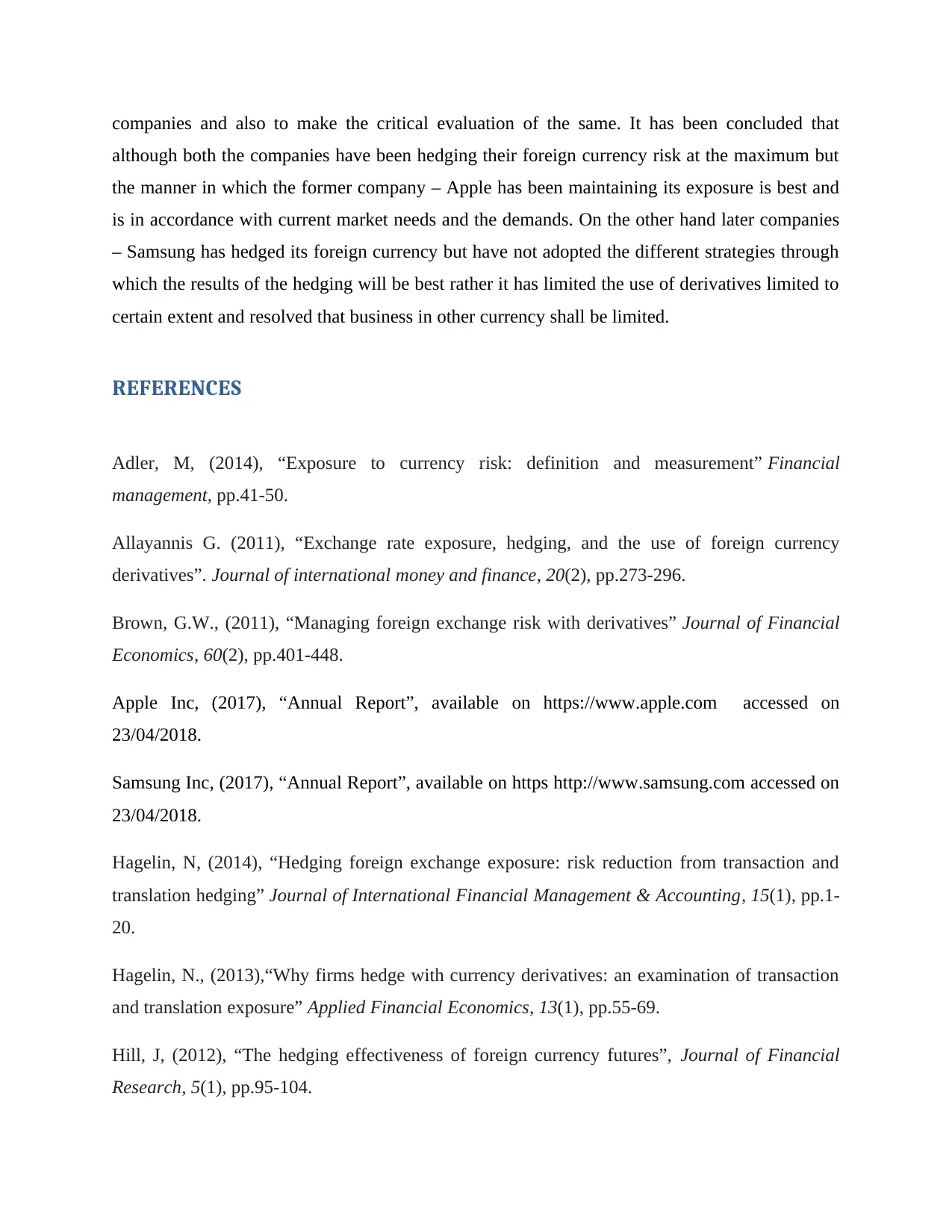
companies and also to make the critical evaluation of the same. It has been concluded that
although both the companies have been hedging their foreign currency risk at the maximum but
the manner in which the former company – Apple has been maintaining its exposure is best and
is in accordance with current market needs and the demands. On the other hand later companies
– Samsung has hedged its foreign currency but have not adopted the different strategies through
which the results of the hedging will be best rather it has limited the use of derivatives limited to
certain extent and resolved that business in other currency shall be limited.
REFERENCES
Adler, M, (2014), “Exposure to currency risk: definition and measurement” Financial
management, pp.41-50.
Allayannis G. (2011), “Exchange rate exposure, hedging, and the use of foreign currency
derivatives”. Journal of international money and finance, 20(2), pp.273-296.
Brown, G.W., (2011), “Managing foreign exchange risk with derivatives” Journal of Financial
Economics, 60(2), pp.401-448.
Apple Inc, (2017), “Annual Report”, available on https://www.apple.com accessed on
23/04/2018.
Samsung Inc, (2017), “Annual Report”, available on https http://www.samsung.com accessed on
23/04/2018.
Hagelin, N, (2014), “Hedging foreign exchange exposure: risk reduction from transaction and
translation hedging” Journal of International Financial Management & Accounting, 15(1), pp.1-
20.
Hagelin, N., (2013),“Why firms hedge with currency derivatives: an examination of transaction
and translation exposure” Applied Financial Economics, 13(1), pp.55-69.
Hill, J, (2012), “The hedging effectiveness of foreign currency futures”, Journal of Financial
Research, 5(1), pp.95-104.
although both the companies have been hedging their foreign currency risk at the maximum but
the manner in which the former company – Apple has been maintaining its exposure is best and
is in accordance with current market needs and the demands. On the other hand later companies
– Samsung has hedged its foreign currency but have not adopted the different strategies through
which the results of the hedging will be best rather it has limited the use of derivatives limited to
certain extent and resolved that business in other currency shall be limited.
REFERENCES
Adler, M, (2014), “Exposure to currency risk: definition and measurement” Financial
management, pp.41-50.
Allayannis G. (2011), “Exchange rate exposure, hedging, and the use of foreign currency
derivatives”. Journal of international money and finance, 20(2), pp.273-296.
Brown, G.W., (2011), “Managing foreign exchange risk with derivatives” Journal of Financial
Economics, 60(2), pp.401-448.
Apple Inc, (2017), “Annual Report”, available on https://www.apple.com accessed on
23/04/2018.
Samsung Inc, (2017), “Annual Report”, available on https http://www.samsung.com accessed on
23/04/2018.
Hagelin, N, (2014), “Hedging foreign exchange exposure: risk reduction from transaction and
translation hedging” Journal of International Financial Management & Accounting, 15(1), pp.1-
20.
Hagelin, N., (2013),“Why firms hedge with currency derivatives: an examination of transaction
and translation exposure” Applied Financial Economics, 13(1), pp.55-69.
Hill, J, (2012), “The hedging effectiveness of foreign currency futures”, Journal of Financial
Research, 5(1), pp.95-104.
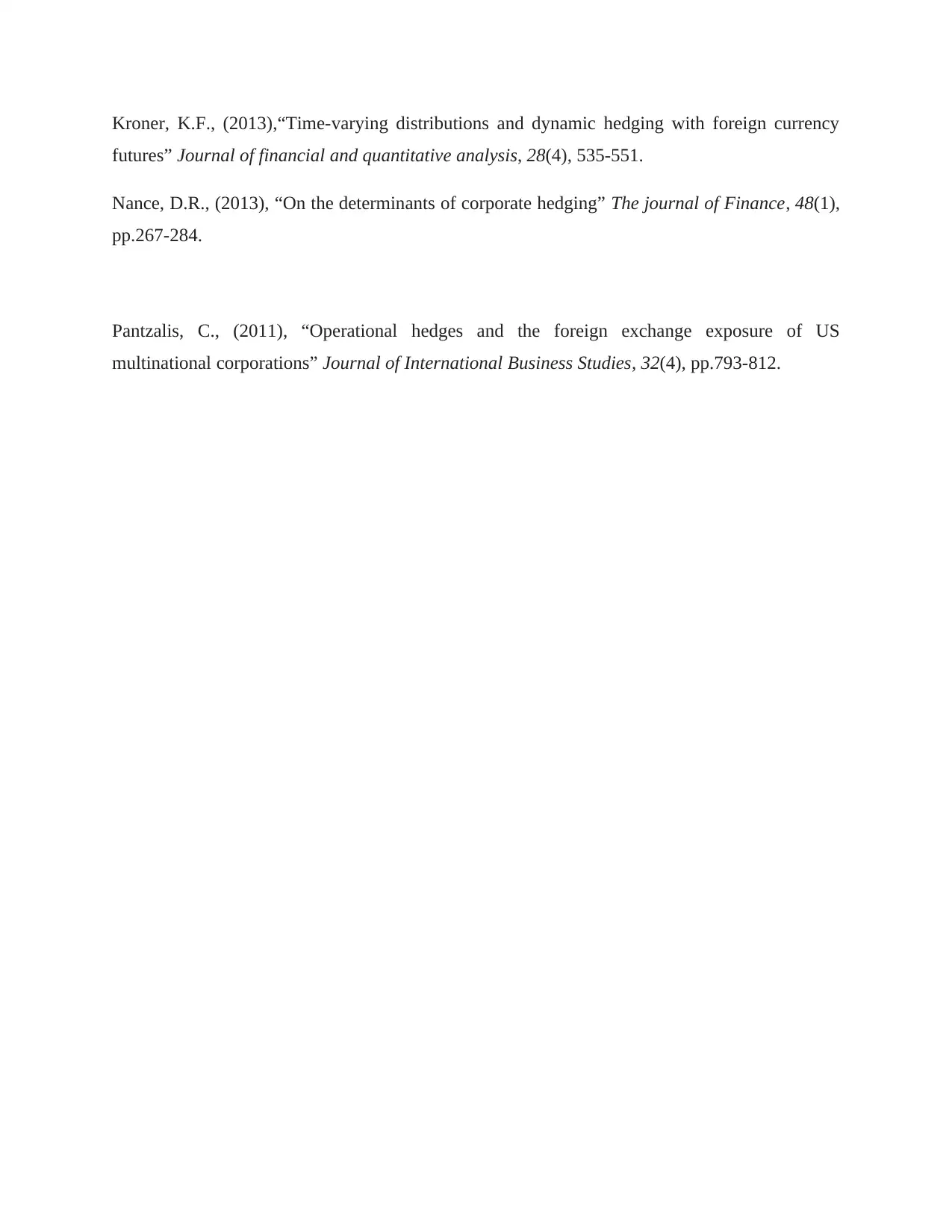
Kroner, K.F., (2013),“Time-varying distributions and dynamic hedging with foreign currency
futures” Journal of financial and quantitative analysis, 28(4), 535-551.
Nance, D.R., (2013), “On the determinants of corporate hedging” The journal of Finance, 48(1),
pp.267-284.
Pantzalis, C., (2011), “Operational hedges and the foreign exchange exposure of US
multinational corporations” Journal of International Business Studies, 32(4), pp.793-812.
futures” Journal of financial and quantitative analysis, 28(4), 535-551.
Nance, D.R., (2013), “On the determinants of corporate hedging” The journal of Finance, 48(1),
pp.267-284.
Pantzalis, C., (2011), “Operational hedges and the foreign exchange exposure of US
multinational corporations” Journal of International Business Studies, 32(4), pp.793-812.
1 out of 10
Related Documents
Your All-in-One AI-Powered Toolkit for Academic Success.
+13062052269
info@desklib.com
Available 24*7 on WhatsApp / Email
![[object Object]](/_next/static/media/star-bottom.7253800d.svg)
Unlock your academic potential
© 2024 | Zucol Services PVT LTD | All rights reserved.





